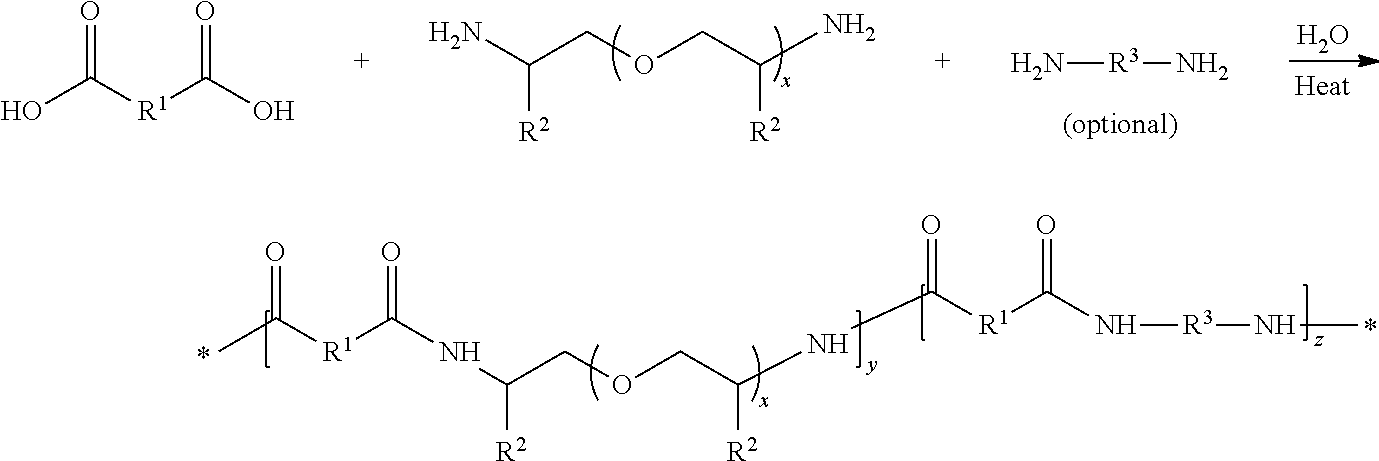Polyetheramide compositions
a technology of polyetheramide and composition, which is applied in the field of alcohol-soluble or dispersible polyetheramide polymers, can solve the problems of unaddressed market needs and current hair fixatives that do not provide the needed properties balance, and achieves smooth and soft feel, good performance and aesthetic results, and low tack
- Summary
- Abstract
- Description
- Claims
- Application Information
AI Technical Summary
Benefits of technology
Problems solved by technology
Method used
Image
Examples
example 1
Synthesis of a Polyetheramide Polymer Comprising 36.1 Wt % PAODA and 45.6 Wt % Diacid
[0101]207.4 g of water was added to a 2000 mL reaction vessel equipped with an agitator, heating mantle, distillation head, and nitrogen purge. While stirring, the water was purged subsurface with nitrogen for approximately 10 minutes, with the purge continued during addition of the remaining reagents. 57.0 g (0.50 moles, 18.3 wt %) of 1,2-diaminocyclohexane, 112.4 g (0.50 moles, 36.1 wt %) of polyoxypropylene diamine (PAODA) having a Mn of about 230 g / mol (available as JEFFAMINE® D-230 from Huntsman Corporation, Salt Lake City, Utah, USA), 141.8 g (0.97 moles, 45.6 wt %) of adipic acid, and 0.62 g of 50% aqueous hypo-phosphorous acid (as catalyst and anti-oxidant) were then added to the stirred aqueous solution. The subsurface nitrogen purge was changed so that the reaction was continued under a blanket of nitrogen. The reaction mixture was heated to 190° C. Once all the water had distilled off, th...
example 2
Synthesis of a Polyetheramide Polymer Comprising 61.3 Wt % PAODA and 38.7 Wt % Diacid
[0102]244.3 g of water was added to a 2000 mL reaction vessel equipped with an agitator, heating mantle, distillation head, and nitrogen purge. While stirring, the water was purged subsurface with nitrogen for approximately 10 minutes, with the purge continued during addition of the remaining reagents. 224.7 g (1.00 mole, 61.3 wt %) of JEFFAMINE® D-230, 141.8 g (0.97 moles, 38.7 wt %) of adipic acid, and 0.73 g of 50% aqueous hypo-phosphorous acid were then added to the stirred aqueous solution. The subsurface nitrogen purge was changed so that the reaction was continued under a blanket of nitrogen. The reaction mixture was heated to 190° C. Once all the water had distilled off, the reaction was continued at 190° C. for 20 hours and then poured off.
example 3
Synthesis of a Polyetheramide Polymer Comprising 58.2 Wt % PAODA and 41.8 Wt % Diacid
[0103]257.2 g of water was added to a 2000 mL reaction vessel equipped with an agitator, heating mantle, distillation head, and nitrogen purge. While stirring, the water was purged subsurface with nitrogen for approximately 10 minutes, with the purge continued during addition of the remaining reagents. 224.7 g (1.00 mole, 58.2 wt %) of PAODA (JEFFAMINE® D-230) and 161.1 g (1.00 mole, 41.8 wt %) of terephthalic acid were added to the aqueous solution. The subsurface nitrogen purge was changed so that the reaction continued under a blanket of nitrogen. The reaction mixture was heated to 240° C. Once all the water had distilled off, the reaction was continued at 240° C. for 5 hours and then poured off.
PUM
| Property | Measurement | Unit |
|---|---|---|
| weight percent | aaaaa | aaaaa |
| elongation-to-break | aaaaa | aaaaa |
| weight percent | aaaaa | aaaaa |
Abstract
Description
Claims
Application Information
 Login to View More
Login to View More - R&D
- Intellectual Property
- Life Sciences
- Materials
- Tech Scout
- Unparalleled Data Quality
- Higher Quality Content
- 60% Fewer Hallucinations
Browse by: Latest US Patents, China's latest patents, Technical Efficacy Thesaurus, Application Domain, Technology Topic, Popular Technical Reports.
© 2025 PatSnap. All rights reserved.Legal|Privacy policy|Modern Slavery Act Transparency Statement|Sitemap|About US| Contact US: help@patsnap.com



